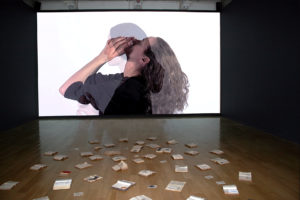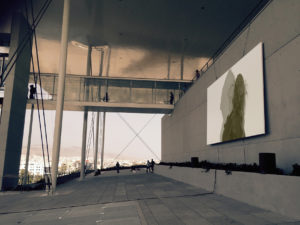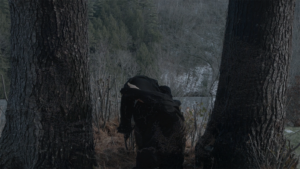Monika Weiss’ Koiman II: Years Without Summers (Nocturne 1, 2 & 3) is a 3-channel digital film & sound installation. Inspired by Franz Schubert’s Winterreise (1828) the installation showcases the first three from the planned 24 films and sound compositions by the artist. In September 2018 the entire project will premiere at Silas Von Morisse Gallery, NY. Weiss is a New York-based artist, filmmaker and composer who received a Harvestworks scholarship award in 2017 to support the audio production for this project.
Saturday, January, 27, 2018, 4 – 6 pm
Harvestworks
596 Broadway Suite 602 New York NY 10012
Phone: 212-431-1130 Subway: F/M/D/B Broadway/Lafayette, R to Prince, #6 to Bleecker
Koiman II – Years Without Summers (24 Nocturnes)
2017-2018
Koiman II – Years Without Summers (24 Nocturnes) is a series of 24 film projections, 24 sound compositions, and 24 large-scale charcoal and graphite drawings inspired by Winterreise (Winter Journey), a cycle of 24 songs for voice and piano composed in 1828 by the German Romantic composer Franz Schubert. It is dedicated to the artist’s late mother, pianist Gabriela Weiss, who passed away in April 2017, and to current refugees and migrants around the world. Each film portrays an anonymous female protagonist performing silent, almost motionless gestures of lamentation, set against dark landscapes of wintery forests and abandoned urban areas. The choreography of movement, slow motion and superimposition are characteristic of Koiman II series. Concurrently, Weiss writes music for each film and works with opera vocalists to perform/record her musical compositions, which she later edits in digital format.
Following the eruption of volcano Tambora, Indonesia in 1815, the spreading ash cloud cooled global temperatures by reflecting and scattering sunlight and impacted weather patterns in Europe and in the northeastern United States. Rain, frost and snowfall occurred throughout the summer of 1816, often described as the “year without summer,” causing agricultural disaster, famine and migration. Scholarly research suggests that severe weather may have inspired works by a number of artists, poets and composers of the time, including Schubert and Turner. The accounts by travellers who were at sea following the Tambora explosion, describe darkness during the day, making it impossible “to see your hand outstretched.” In Weiss’ Koiman II, this darkness is a metaphor for how our culture and civilization today cannot truly see its own future, past “the hand stretched”.
“Two hundred years later the world appears to me as if shrouded in a symbolic ash cloud resulting from the global climate change, the collapse of Arab Spring, the current refugee crisis and the gradual and global move towards fascist ideologies. My project Koiman II is meant to evoke this notion of darkness, eruption, explosion, coldness and clouding, and is greatly affected by global conditions—such as displacement, violation and exploitation of bodies of others—which mirror the abuse and gradual disintegration of the natural environment resulting from colonial agendas.” – says Weiss.
For Koiman II, the artist composes 24 songs (without words) for voice, as a musical response to each song in Schubert’s Winterreise, to be recorded by an opera vocalist. She will also record her own piano improvisations in response to each of Schubert’s songs. She will work with volunteers whom she will ask to read passages from literature and poetry in various languages as well to read the memoires by the survivors of the volcano eruption, and speak their own thoughts inspired by my project. She will digitally mix and alter those layers of sound into new polyphonic whole. As in her filmmaking technique, in Weiss’ musical composition for this project, she reverses and alters certain fragments of sound to articulate suspended and non-linear time.
Weiss describes her film and video work as “usually almost motionless, as if they were paintings. A scene is often shown from a stationary camera viewpoint, adding to a sense that one is observing a painting, rather then watching a film”. Koiman II comprises 24 such “still-films,” each showing an almost motionless portrait of a female figure set against a nocturnal landscape, either urban or natural. Each figure is kneeling or seated, veiled, anonymous, silent, lamenting, her body appearing doubled by superimposing two time sequences. The backdrop landscape is inspired by how the artist imagines the red snow, the brown rains, and the dark skies described in the memoirs of the witnesses of the summer of 1816, evoking also German romantic paintings and modernist experimental film sets. Weiss also relates this project to the work of American experimental filmmaker Maya Deren (b. Eleanora Derenkowskaia, Ukraine). The project also includes twenty-four large-scale charcoal and graphite drawings evoking traces of explosion and connoting volcanic ashes. Each drawing exists as an independent work. Each drawing also appears momentarily superimposed with the figure in each film in Koiman II series.”
This work is dedicated to my late mother, pianist Gabriela Weiss who passed away in April 2017, and to all currently displaced refuges and migrants trying to find shelter. As a child I spent hours listening to her practicing Chopin’s Nocturnes. Forever scarred by the war, as a little child refugee in her mother’s arms, my mother barely escaped a hunt that both Soviet and German occupants systematically exercised in Europe.
To date this project received generous support from the following institutions:
HARVESTWORKS media center, NEW YORK
BRIC media center, BROOKLYN, NY
YADDO foundation, SARATOGA SPRINGS, NY
BIO
Monika Weiss is an artist, filmmaker and composer based in New York City since 2001. Weiss’ work is currently represented by Silas Von Morrise Gallery, New York and Galerie Samuel Lalouz, Montreal and featured in pubic collections and publications worldwide. Born in Warsaw, Poland she graduated from Warsaw School of Music and Warsaw Academy of Fine Arts. Her solo museum exhibitions include the 2005 retrospective at the Lehman College Art Gallery/CUNY, Five Rivers, reviewed in The New York Times, as well as Sustenazo, commissioned by the CCA Zamek Ujazdowski, Warsaw/Poland (2010), and later shown at Museum of Memory & Human Rights, Santiago/Chile (2012-2013) and Patricia & Phillip Frost Art Museum, Miami (2014). Her work has been featured in international group exhibitions, including at the Cisneros Fontanals Art Foundation, Miami (Forms of Classification, 2006; The Prisoner’s Dilemma, 2008) and was part of Prague’s Muzeum Montanelli’s inaugural show in 2010. Commissioned by The Drawing Center, her public project Drawing Lethe (2006) took place at the WFC Winter Garden within sight of Ground Zero.
In Shrouds (2012), Weiss filmed, from an airplane, local women performing silent gestures of lamentation on the abandoned, forgotten site of the former concentration camp for women. Her Two Laments (19 Cantos), 2015-2017, is a series of films and sound compositions inspired by events in India and dedicated to two forms of globally occurring violence: the rape of women and the colonial subjugation of cities. In 2016 her film and sound composition Wrath was presented in Fireflies in the Night Take Wing, an international survey curated by Barbara London, Kalliopi Minioudaki, Francesca Pietropaolo, and artistic director Robert Storr for at The Stavros Niarchos Foundation Cultural Center in Athens, Greece.
Press Quotes
n.paradoxa. international feminst art journal, London, UK
Volume 37/ January 2016, “SOUND?NOISE!VOICE!”
- 83-88
Monika Weiss’ Two Laments by Vanessa Gravenor
“Within Two Laments (19 Cantos), instead of an object signifying loss, trauma is transformed into sound. One hears this sound in the first cantos where Weiss’ poem This is My Ribbon appears in subtitles. This is My Ribbon is performed in spoken word in languages of Sanskrit, Hindi, Bengali, and Oriya. These languages are meant to represent minor tongues that resist an official colonial English. It is the second canto, however, that loss is transformed into music. Weiss wrote a short melody for classical format, which an Indian Carnatic Singer then performed. Here, loss is imbued with living presence and transformed into elegy. This elegy, which is performed just with the human voice and no instruments, resists set formats and stability.” (Vanessa Gravenor, 2016)\
Stavros Niarchos Foundation Cultural Center, Athens, Greece
Fireflies in the Night Take Wing, Press Release, June 2016
Artistic Director: Robert Storr, Curators: Barbara London, Kalliopi Minioudaki, Francesca Pietropaolo
“Music is central to the Greek National Opera housed in the SNFCC and the affective means through which several artists explore various topics... Monika Weiss’s vocal and piano compositions dramatize the visual and performative lamentation gestures through which she explores personal, gendered and collective trauma… Monika Weiss’ Wrath (Canto 1, Canto 2, Canto 3) is a poignant ritualistic contemplation on all kinds of violence whose gendered association of wounded female and urban bodies resonates with the contemporary refugee crisis in Greece, even while it originates from an unrealized project inspired by the Arab Spring. The film foregrounds a signature performative device in Monika Weiss’ recent work—lamentation—as a powerfully political, yet fundamentally ethical means to deal with personal, gendered and collective trauma by “dignifying and veiling it with anonymity,” in the artist’s words.” (Kalliopi Minioudaki, Ph.D., 2016)
Gulf News
Exploring the Concept of Absence, by Jyoti Kalsi, July 2017
“The show includes a film by Polish American artist Monika Weiss, titled Sustenazo (Lament II). By combining emotional visuals and sounds referencing the best of German literature and painful memories of the holocaust, she weaves a layered narrative about the positive and negative aspects of European heritage and its connections with other regions and histories around the world. While enacting ancient gestures of lamentation, the work questions the absence of empathy and awareness of history in contemporary society as well as the choices we make about preserving memories of the past.” (Jyoti Kalsi, 2017)
ArtNexus, Issue #65 Jul – Sep 2007
Forms of Classification: Alternative Knowledge to Contemporary Lethargy
Review by Janet Batet
“The construction and deconstruction of history, emphasizing its suppressions and omissions, connects the works of the second group of artists, which include Mark Dion, Mathilde ter Heijne, Susan Hiller, and Monika Weiss. The themes or areas of investigation are dissimilar, from archaeology or women’s self-sacrifice to Nazism (Monika Weiss), but always centered around the deconstruction of stereotypical discourse that becomes unmovable version.” (Janet Batet, 2007)

Monika Weiss-Sustenazo (Lament II) 2010-2012 View of solo exhibition at Museum of Memory & Human Rights, Santiago, Chile, December 2012 – April, 2013
Website and Social Media Sites
https://www.facebook.com/monika.weiss.963

Monika Weiss Wrath (2015) View of the exhibition Fireflies in the Night Take Wing, Stavros Niarchos Foundation Cultural Center, Athens, Greece, 2016. Artistic Director: Robert Storr Curators: Barbara London, Kalliopi Minioudaki, Francesca Pietropaolo.
Links To Past Interviews and Press Coverage
https://www.ktpress.co.uk/nparadoxa-volume-details.asp?volumeid=37 (2016)
http://www.tabletmag.com/jewish-arts-and-culture/204150/the-lamentation-project (2017)
The Streaming Museum (2017)








